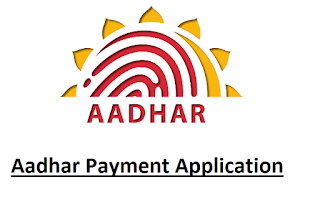Aadhaar payment app for merchants.
Aadhaar payment app:Debit/Credit card payments and PoS machines will start disappearing from retail outlets in India soon.On 25th December GoI(Governemnt of India) anounced launch of AEPS (Aadhaar Enabled Payment System) app.After the demonetization Modi goverment is pacing up the process of cashless payment systems.Introduction of this governemnt controlled AEPS (Aadhaar Enabled Payment System) app would silence the critics of BJP governments' vision of cashless economy since no private 'digital wallet' players like 'paytm' ,'jiomoney' etc.. are involved in this venture.
Aadhaar Pay, launched by the government , has been developed by IDFC Bank in association with Unique Identification Authority of India (UIDAI) and the National Payments Corporation of India (NPCI), the bank said in a statement. IDFC Aadhaar Pay will enable millions of merchants across the country to facilitate cashless purchases for customers in a cost-effective and scalable way.
"This app can be used by a person to make payments without any phone. Almost 40 crore Aadhaar numbers already stand linked to bank accounts – that is half the adults in India. The aim is to link all Aadhaar numbers with bank accounts by March, 2017".Ajay Bhushan Pandey, CEO, Unique Identification Authority of India (UIDAI)
"The settlement is done through the Aadhaar bridge, which means it connects a much wider set of people. Anybody who has Aadhaar seeding done can make payments to merchants with this app. It wouldn’t matter if the person does not have a credit or debit card, or even a mobile phone."
Rajiv Lall, MD & CEO at IDFC Bank
How to use Aadhaar Payment App
Pre-requisites for using Aadhaar pay (Aadhaar Payment App)
- To pay using aadhaar payment app, merchant needs a smartphone connected to a biometric scanner or an inbuilt finger print scanner.
- The bank accounts of both merchant and the customer need to be linked with aadhaar to make aadhaar enabled payments.
Here is the step wise procedure for using Aadhaar Payment App.
- Merchants need to download and install the Aadhaar cashless merchant app on their smartphones (android users can download from playstore and iOS users can download it from iTunes)
- Connect a biometric reader(finger print scanner) to the phone
- Enter the details of Merchant's Aadhaar linked bank account information and register.
- To accept payment from a customer, enter the Aadhaar number of customer.
- Enter Customer’s bank name and amount to be paid.
- Validate the transaction using customer’s fingerprint.
- After successful authorisation, the amount will be transferred from customer’s bank account to merchant’s bank account.
Aadhar Pay – Aadhar Payment App
Advantages of Aadhar Pay Application
- The Main Benefits of Aadhar Payment Application are as Follows.
- No PIN or OTP (One time Password) is Required to Transfer Money.
- No need to Carry any type of Plastic Card(credit/debit).
- No Payment Charges.
simon
No comments:








